by Lisa Cooke | Mar 15, 2017 | 01 What's New, Irish, Legacy Tree Genealogists
Irish genealogy help is on the way! Starting your own Irish genealogy research can be intimidating. Lack of records and distance are just two obstacles to overcome. Lisa interviews Kate Eakman, Professional Genealogist specializing in Irish genealogy at Legacy Tree Genealogists. Kate provides the best practices for being an effective do-it-yourselfer, and explains how to hire a pro when you need one. 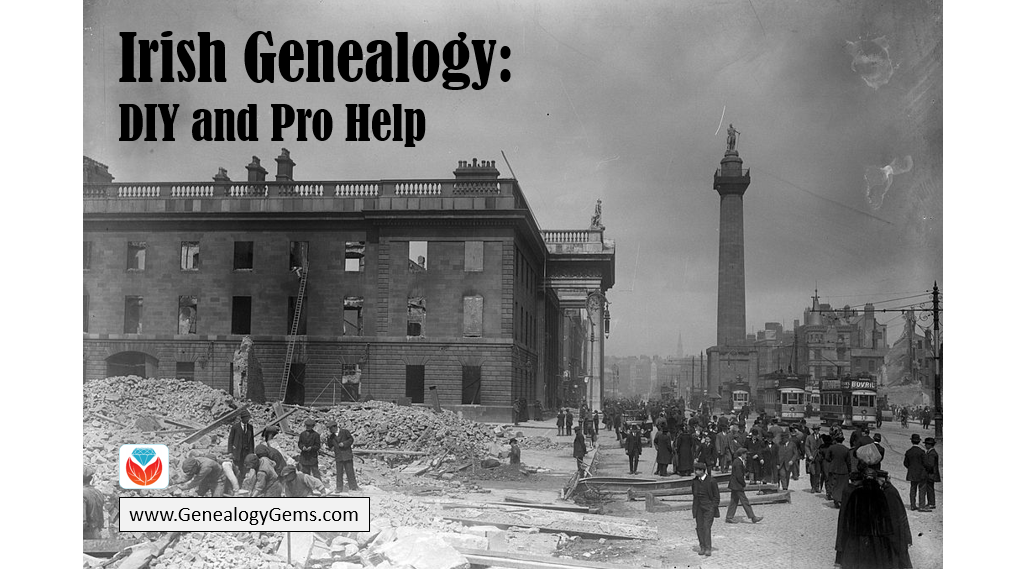 If you haven’t had the chance to listen to Genealogy Gems Podcast episode 196, I’d like to share a few highlights regarding getting started with Irish genealogy. We all know it can be difficult, and there are lots of rumors suggesting records no longer exist. Here are a few key points Kate Eakman shared with me in our interview.
If you haven’t had the chance to listen to Genealogy Gems Podcast episode 196, I’d like to share a few highlights regarding getting started with Irish genealogy. We all know it can be difficult, and there are lots of rumors suggesting records no longer exist. Here are a few key points Kate Eakman shared with me in our interview.
Irish Genealogy Help: A Pro Interview with Kate Eakman
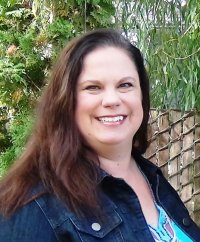
Kate Eakman
Q: Where would you recommend the hobbyist start their Irish search?
A: A huge number of Americans identify as part Irish. One difficulty in Irish research is there are not a lot of Irish records available online for free. There are some, however, and these are important places to start. Top sites for free Irish records include: – FamilySearch.org (click here for their Ireland landing page), – National Archives of Ireland, – Irishgenealogy.ie, – and Findmypast.com (click here for their Ireland page.) I particularly like Irishgenealogy.ie. They have some civil and church records available for various counties. Findmypast also has a great selection of Irish records and some are even free!
Q: What does a researcher need to know before ‘crossing the pond’?
A: Before ‘crossing the pond’ (and digging into Irish records), an important piece of information to obtain would be: where was the person born in Ireland? In particular, the county. Next, find out if they were Protestant or Catholic. Click here for an interactive map of Irish counties, including those of Northern Ireland to help you. By learning the county of birth, you will save yourself time and difficulty. Many of the records you need will be kept on this county level.
Q: Where do you recommend they look for finding which county their ancestor was born in?
A: I would begin with death records, marriage records, church records, passenger lists, and naturalization papers. Keep an eye out for known extended family members who may have come from the same place. You can also school yourself in traditional Irish naming conventions and patterns, as this is always helpful.
Q: At what point in the Irish research process do hobbyists usually get stuck?
A: Common names regularly recycled can often cause researchers to get stuck. It can be tough to sort out who is who. Also, a huge fire at the Public Records Office in Dublin in 1922 destroyed the bulk of government records. Click here for a description of what was lost and what surviving fragments are coming soon to Findmypast.com. Remember, there are always ways in which we can overcome these research barriers and get you the Irish genealogy help you need.
Q: Sometimes we need help. You are a professional genealogist at Legacy Tree Genealogists. How does one begin work with a professional genealogist?
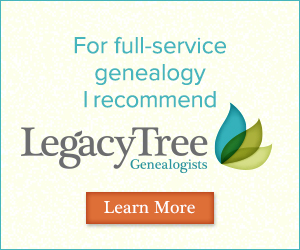 A: Our process is easy. If you just need help figuring our your next steps, a Genealogist-on-Demand™ 45-minute genealogy consultation for just $100 is the ideal solution. Learn more and schedule your appointment here.
A: Our process is easy. If you just need help figuring our your next steps, a Genealogist-on-Demand™ 45-minute genealogy consultation for just $100 is the ideal solution. Learn more and schedule your appointment here.
For larger projects, go to our website and begin with a free consultation. A manager calls or emails you, the client, to discuss your needs and parameters. We identify the goals and determine what the client already knows. A goal, the time required, and the research packet needed is settled on. Then, a researcher is assigned to the client. A written report of the research conducted is provided to the client. And, we have a great starter package. The Legacy Tree Discovery package provides for 3.5 hours of preliminary analysis and research recommendations. It’s a great choice if you’ve hit a brick wall in your research and could use some expert guidance.
Get these tips and more on the free podcast!
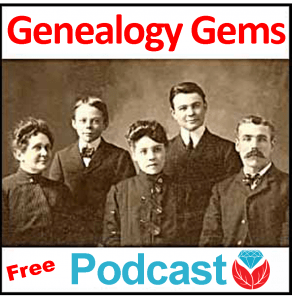 Are you listening to The Genealogy Gems Podcast yet? This free audio show helps you make the most of your family history research time by providing quick and easy-to-use research techniques. Producer and host Lisa Louise Cooke brings you the best websites, best practices, and best resources available. This podcast is 100% free! Click here to start listening right now on our computer.
Are you listening to The Genealogy Gems Podcast yet? This free audio show helps you make the most of your family history research time by providing quick and easy-to-use research techniques. Producer and host Lisa Louise Cooke brings you the best websites, best practices, and best resources available. This podcast is 100% free! Click here to start listening right now on our computer.
On your smartphone or tablet it’s as easy as 1-2-3:
- Open your device’s podcast app: Apple Podcasts on the iPhone / iPad, or Google Podcasts on Android
- Search for “Genealogy Gems”
- When the show pops up, tap the “Subscribe” button so you’ll instantly get new episodes when they’re published!
Disclosure: This article contains affiliate links and Genealogy Gems will be compensated if you make a purchase after clicking on these links (at no additional cost to you). Thank you for supporting Genealogy Gems!
by Lisa Cooke | Mar 13, 2017 | 01 What's New, DNA
Do you need help solving your family migration patterns? A groundbreaking new scientific study uses DNA and family trees to map migration routes across North America.

Family Migration Patterns Revealed in Genomes
A new study published in Nature Communications represents a ground-breaking development in using DNA for genealogy. The article from the AncestryDNA Scientific Team is titled Clustering of 770,000 genomes reveals post-colonial population structure of North America. Or, in more understandable terms, “Your DNA can tell us where you came from in America in the last 500 years.”
Wow, right? So, how did they do this?
The power really is in the numbers. In this particular paper, they started with using their autosomal DNA test on 770,000 people. Some of them were AncestryDNA customers who had consented to be part of the research. From these 770,000, they learned quite a bit about the migration patterns of early Americans. As Ancestry analyzes more individuals using these same principles of correlating genetics and genealogy, this data will improve and be able to tell us even more about our heritage. Even though it takes a large data set to figure out the relationship between our DNA and migration patterns, it really comes down to the relationship of two people.
To start, Ancestry determines how just two people are genetically related. Then, they find how those two are related to a third person, again, looking only at pairs of people. This goes on and on until everyone in the group as been compared. They use a graph to plot those relationships, with those more closely related clustering around each other. And then it happens. The point where we see the marriage of genetics and genealogy suddenly appear by adding in the family history information for each of these individuals in the cluster.
What they found was astounding. They have displayed the data in Figure 3 shown below. It is a map of the United States with colored dots scattered across the landscape. The location of the dots corresponds to the genealogy of those tested, while the color of the dots relates to their genetic clustering. Those who cluster closest together are the same color. The result is a nearly perfect rainbow, with buy anti anxiety medication online uk each color holding its respective spot on the map, with very little overlap between groups.
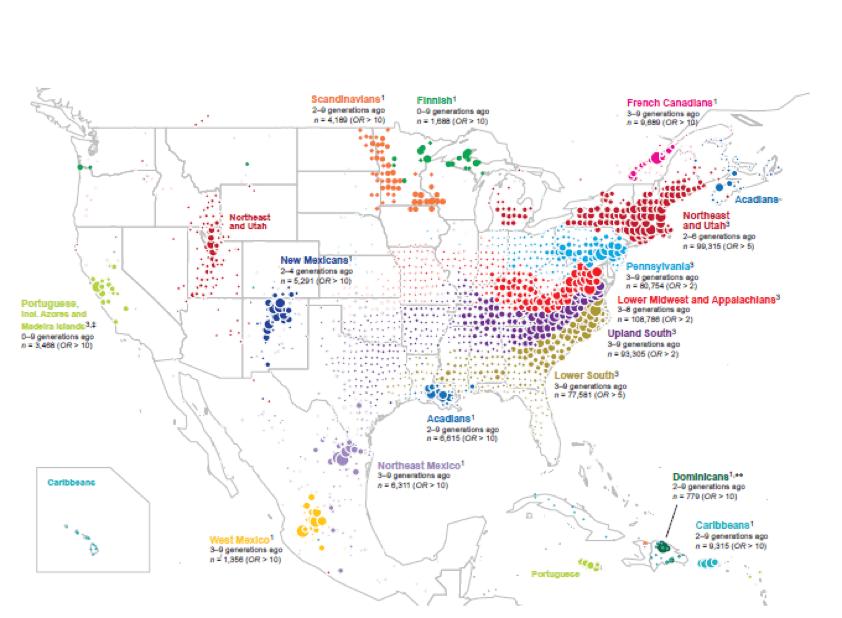
Distribution of ancestral birth locations in North America. Summary map from Nature Communications; click to see article with full explanation of map data. Image used with permission of Ancestry.com.
We might be tempted when looking at the map to think, oh, well, of course there is a large population of European Jews in New York, everyone knows that. But this isn’t their family history, their accent, or their culture telling us this – it is their genetics!
As if that wasn’t exciting enough, the scientists describe how we can trace family migration patterns of different groups over just a few generations. They specifically mention French Canadians and Cajuns/Acadians, but the same principle can theoretically be applied to dozens of other groups.
Family Migration Patterns and Applying these Findings
 So what does this mean for you as a genealogist?
So what does this mean for you as a genealogist?
It means we are getting closer than ever to being able to tell who you are and where you came from using your DNA.
For example, let’s say you have an ancestor in Texas about 4 generations ago, but you aren’t sure where she came from. Your DNA could tell you that you fit into the Lower South group, meaning that your ancestor likely hails from the south. Or, maybe your genetics identify with the Upland South, which means you need to explore records from Arkansas, Tennessee, and North Carolina.
This is just a glimpse into the advances that genetics are bringing to your genealogy toolbox these days. So it’s high time to go “all in” to learn about genetic genealogy! We recommend The Family Tree Guide to DNA Testing and Genetic Genealogy by Blaine Bettinger. You’ll love this book if:
- You’ve got brick walls that traditional research methods haven’t been able to break down
- You want to take advantage of the hottest tool in genealogy
- You’ve already taken a DNA test and want to know what comes next
Disclosure: This article contains affiliate links and Genealogy Gems will be compensated if you make a purchase after clicking on these links (at no additional cost to you). Thank you for supporting Genealogy Gems!
by Lisa Cooke | Mar 12, 2017 | 01 What's New, Irish, Legacy Tree Genealogists |
Let’s trace your Irish ancestors! Irish research tips are a must-have for this historically violent little island. Senior Researcher at Legacy Tree Genealogists, Kate Eakman, shares with you four historical and geographical tips to get you off to the right start.
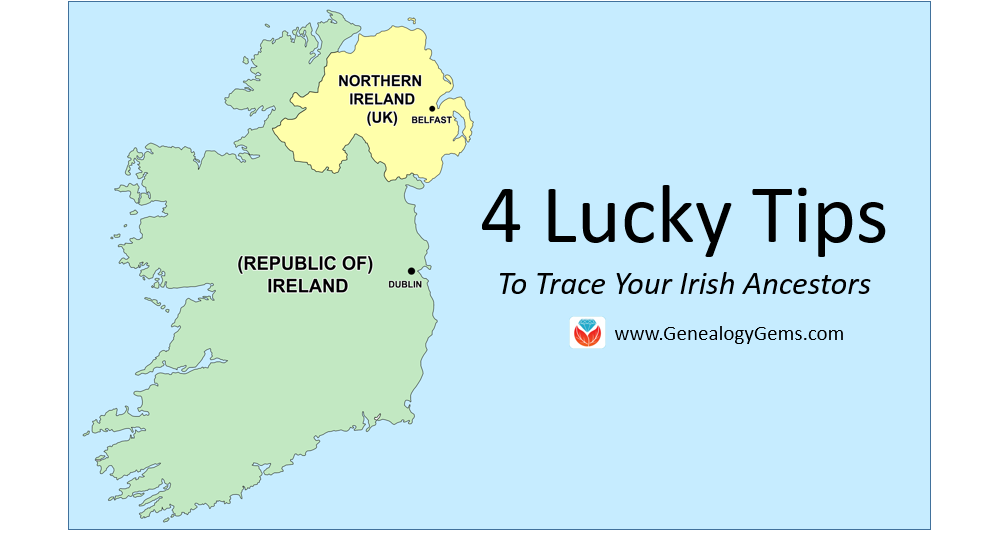
By Jonto at English Wikipedia [GFDL (http://www.gnu.org/copyleft/fdl.html) or CC-BY-SA-3.0 (http://creativecommons.org/licenses/by-sa/3.0/)], via Wikimedia Commons
Trace Your Irish Ancestors: 4 Tips

Kate Eakman from Legacy Family Tree Genealogists
Irish research can be difficult. Although the island is small–about the same size as the state of Indiana–its violent history and many divisions makes research complicated. In addition, many United States records simply report our ancestors were from Ireland with no indication of the county of their birth. However, knowing a little bit about the history and geography can provide the necessary clues. Here are four tips that can help you trace your Irish ancestors from the United States back to Ireland.
Tip 1: Understand the Island of Ireland Today
There are two distinct political entities on the island of Ireland: Northern Ireland and the Republic of Ireland. The dividing line was drawn by England in 1922. This is an important date to keep in mind when searching for more recent Irish ancestors.
The Republic of Ireland, or Eire, is an independent nation made up of the southern 26 counties of Ireland. The Republic of Ireland is predominantly Catholic, with about 3% of the population identifying itself as Protestant. Indices and links to copies of the civil birth records for the years 1864 to 1915, marriages between 1882 and 1940, and death records between 1891 and 1965 are available for free from the IrishGenealogy website. (These records include those of the Northern Irish counties up to 1922.) Official copies can be ordered from the General Records Office in Dublin.
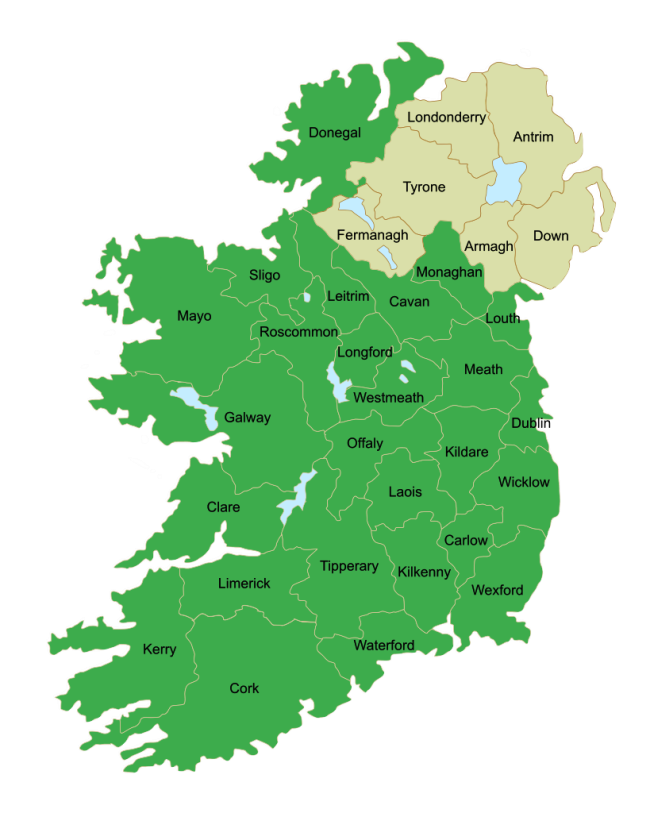
Map of the counties of Northern Ireland and the Republic of Ireland. Photo courtesy https://commons.wikimedia.org.
Northern Ireland, also known as Ulster, is a part of the United Kingdom–although it is self-governing like Canada or Australia. Although the counties of Northern Ireland are not officially used today, it is comprised of the traditional counties of Antrim, Armagh, Down, Fermanagh, Tyrone, and Londonderry (also known by the more traditional name of Derry). Although most Americans believe that Northern Ireland is a Protestant nation, the reality is that today there are almost an equal number of Catholics as there are Protestants in Northern Ireland. Civil birth, marriage, and death records can be ordered from GRONI (General Records Office Northern Ireland).
Tip 2: Turn to U.S. Census Records
From the 1880 U.S. Census through the 1920 U.S. Census, Irish ancestors who immigrated to the United States, or whose parents were natives of Ireland, simply reported they were natives of Ireland. However, since the 1930 U.S. Census was taken after the creation of the Republic of Ireland in 1922, it often noted the specific country from which ancestors originated.
In this sample (below) from the 1930 U.S. census, we can see John O’Reilly was born in “North. Ireland,” as were his mother and her parents. His father, however, was from the Irish Free State, or the Republic of Ireland. This information tells us where to search for John’s birth: in one of the six counties of Northern Ireland. His mother’s birth record will also be from Northern Ireland, and probably his parents’ marriage record also, since it is more traditional to marry in the bride’s hometown than the groom’s.
There is the potential that a much larger search will be necessary for John’s father’s birth record unless the marriage record can be found and it specifies in which of the 26 Republic of Ireland counties he was born.

John J. O’Reilly and his mother in the 1930 U.S. Census report. The detail shows where John was born, then his father’s place of birth, followed by his mother’s place of birth. The second line was the same information for John’s mother. Images courtesy http://ancestry.com.
If your Irish ancestor, or the child of that ancestor, is listed in the 1930 U.S. census, pay close attention to where they reported they and their parents were born. You might find a very helpful clue in that census report.
Tip 3: Look to Religion for Clues
While many people associate Roman Catholicism with Ireland, there are many Protestants living in Northern Ireland and fewer in the Republic of Ireland. Knowing your family’s historical religious preference can provide a small hint. If your family has always been Catholic it is likely they were Catholics in Ireland. However, as we have already noted, with almost all of the Republic of Ireland expressing a preference for Catholicism and about 45% of the citizens of Northern Ireland claiming allegiance to the Catholic faith, you can see a Catholic religious heritage is not particularly unique.
However, if your family history includes the Episcopal faith, or there is something that references “the Church of Ireland” in your family’s records, then your family was most likely Protestant when they lived in Ireland. You are also more likely to find your Protestant ancestors in Northern Ireland (with the understanding that there are Protestants throughout the Republic of Ireland).
If your family is or has been Presbyterian, there is a very strong likelihood your family is actually Scots-Irish with your ancestors immigrating to Ireland from Scotland, bringing their Scottish religion with them. You will find most of these ancestors in Northern Ireland.
Tip 4: Move on to Military Records
World War I (1914-1918) was particularly brutal to the Irish. More than 30,000 of the 200,000 men who enlisted were killed in this war. Songs such as “Gallipoli” and “The Foggy Dew” mourned the loss of so many young Irish men in foreign wars, especially since the 1922 Irish War of Independence followed closely on the heels of World War I.
If one of your Irish ancestors fought and died in World War I, you can find his name and more at the website Ireland’s Memorial Records. Many (but not all) of the memorials include the county in which the soldier was born, as seen below:
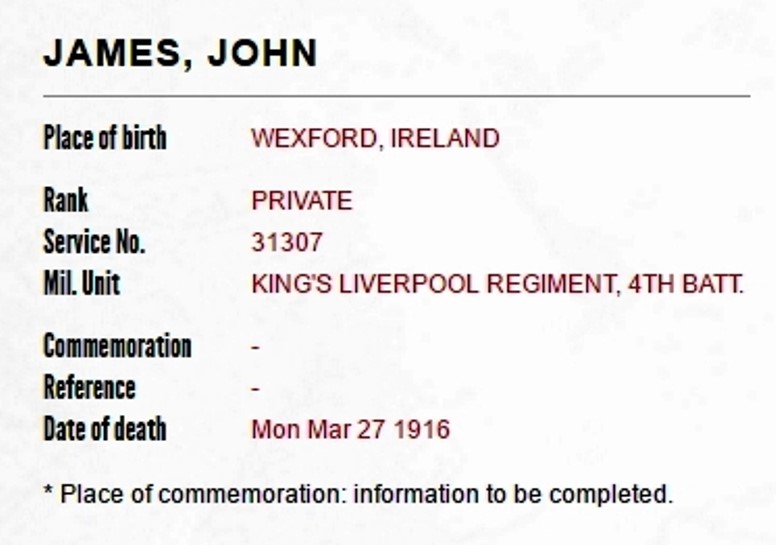
Memorial for John James of County Wexford. Courtesy Ireland’s Memorial Records.
Another website, Ireland’s World War I Veterans 1914-1918, has created a PDF list, updated every three months, which contains over 35,000 names of Irishmen who fought in World War I. If you know or suspect your Irish ancestor may have served in World War I and survived the experience, this is an excellent place to find a clue about his origins.
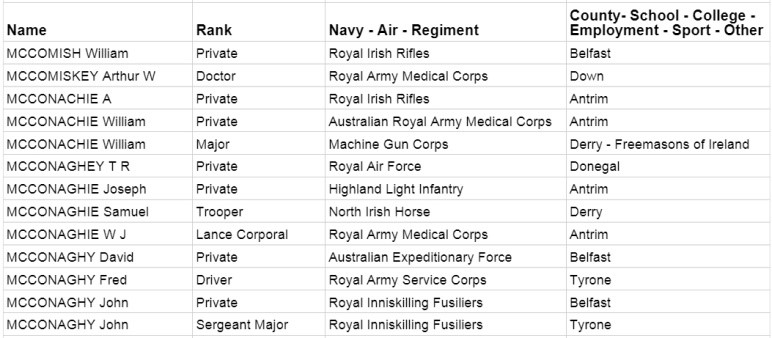
A sample of the list of those who served as created by Ireland’s World War I Veterans 1914-1918.
Although it can be difficult to find the correct place in Ireland for your family’s origins, there are some important clues, both historical and geographical, that can help you pinpoint a place to begin your search in Ireland.
Trace Your Irish Ancestors: In Conclusion
 The 1930 U.S. census can provide an important clue to trace your Irish ancestors, as can your family’s religious heritage. If an Irish ancestor served in World War I, you may be able to determine the county in which he was born. A knowledge of the differences between Northern Ireland and the Republic of Ireland, as well as their location and the counties within those two countries, can help you contact the proper vital records office for those all-important vital records. So, go n-éirí leat! Good luck!
The 1930 U.S. census can provide an important clue to trace your Irish ancestors, as can your family’s religious heritage. If an Irish ancestor served in World War I, you may be able to determine the county in which he was born. A knowledge of the differences between Northern Ireland and the Republic of Ireland, as well as their location and the counties within those two countries, can help you contact the proper vital records office for those all-important vital records. So, go n-éirí leat! Good luck!
The team of expert genealogists at Legacy Tree Genealogists can help bust through your brick walls. They do the research and you enjoy the discoveries!
by Lisa Cooke | Mar 11, 2017 | 01 What's New, RootsMagic |
A GEDCOM file is a universal type of file that genealogists use to move data from one genealogy software program to another. Using these helpful tips below, you can open genealogy files your family members send to you, or share your data with others.
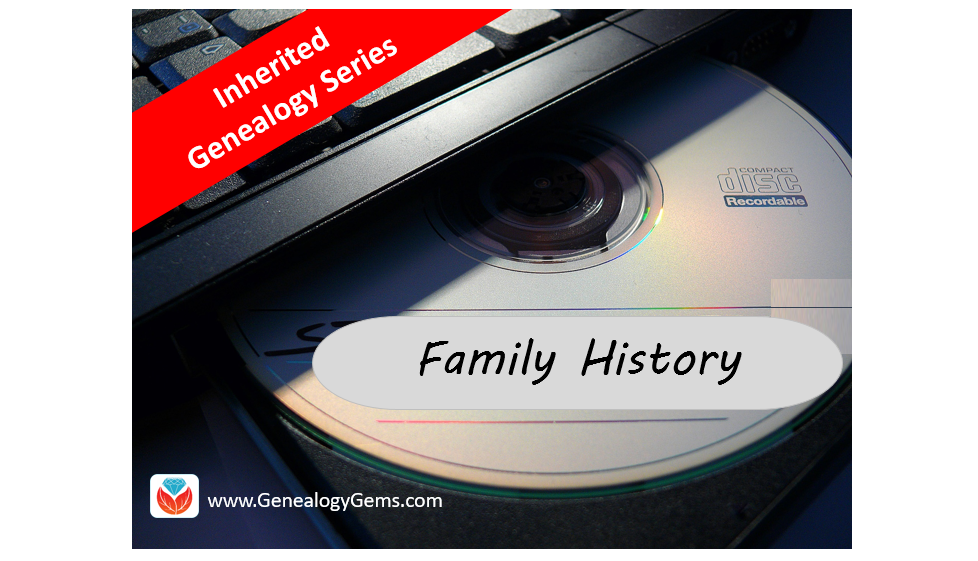
When and Why You Would Need to Open a GEDCOM File
A Genealogy Gems reader recently wrote:
I recently signed up for [the Genealogy Gems] newsletter. I received a CD from a relative with family history information that was set up through Family Tree Maker. I am currently not subscribed to any of the genealogy sites. My question is, how can I retrieve this information [from the CD.] Can you help?
The answer to the question is: Use another program to open the GEDCOM file from the CD. Let me show you how easy it is to open and create GEDCOM files.
GEDCOM Basics
GEDCOM is an acronym standing for Genealogical Data Communication. It is a universal genealogy file that allows you to exchange genealogical data between different genealogy software programs.
Because it is “universal” in nature, a GEDCOM file can be read by many different types of genealogy software. That means, if you are using RootsMagic, you can still share all the data you have collected with your cousin who uses Family Tree Maker, and she will not have to type in all the names, dates, and places manually.
Occasionally, not all the information included in a GEDCOM file will transfer perfectly. There are differences in how that information is interpreted and some things, like notes and sources, may be affected. However, for the most part, much of it will transfer correctly.
How to Open a GEDCOM File
Our reader needs to open a GEDCOM file contained on the CD he was sent. To do this, he must have a program on his computer that will read a GEDCOM file. There is an option I would like to share with you.
RootsMagic is a downloadable software for both Mac and PC users. (And, it is the one we here at The Genealogy Gems Podcast use! That’s why we accepted them as a sponsor of the podcast.)
Once you have downloaded RootsMagic to your computer, open it. At the top left corner, click on File and from the pull-down menu, choose Import.
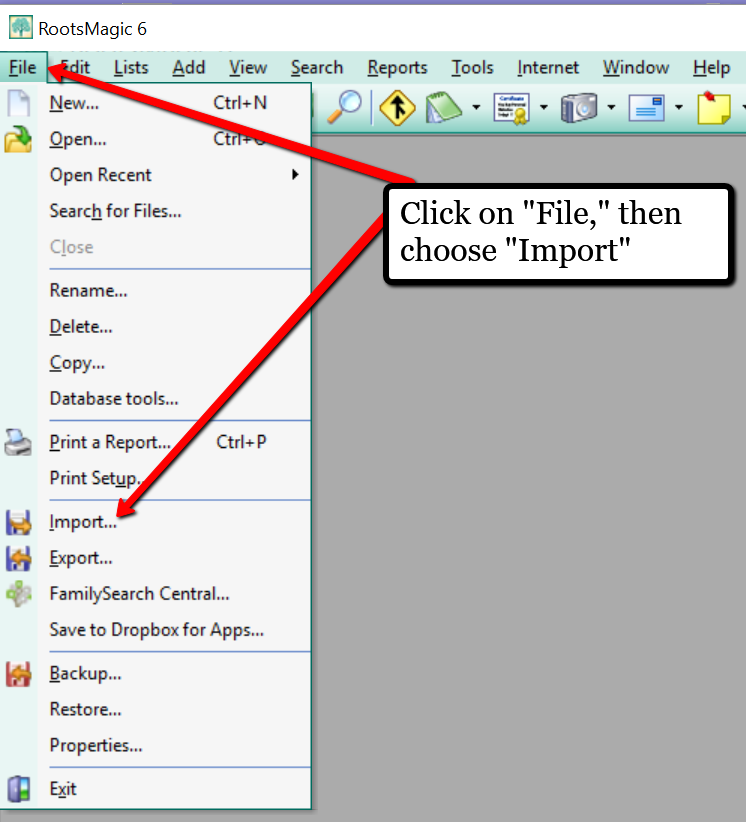
Now, a new pop-up window will open and ask from what source you would like to import from. You will notice several options, but for our reader’s question, he will choose the GEDCOM option.
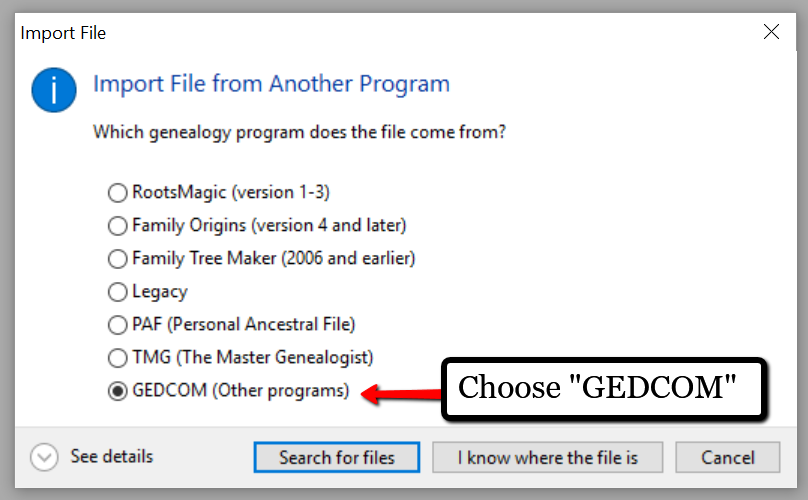
Then, choose I know where the file is, and the file explorer window will appear. In this case, our reader would click on the CD that he has loaded into his computer’s disk drive, and follow the prompts to open the GEDCOM file. All that information his relative sent him will be slurped into RootsMagic and he can easily look through the pedigree of his family.
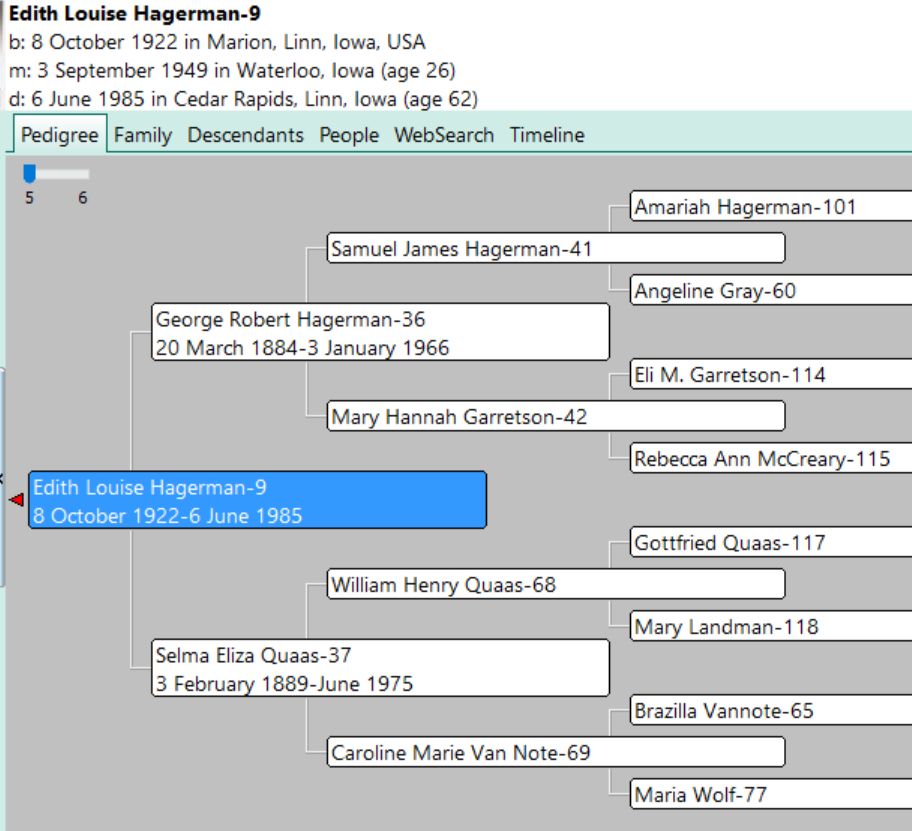
Creating a GEDCOM to Share with Others
RootsMagic also allows you to create a GEDCOM file. This is what you would send to your relatives when they would like to have a copy of the family tree.
To do this, open RootsMagic. Click on File, as we did before, and this time choose Export from the pull-down options.
The export box will pop-up. You can choose what you wish to have included in this export. I typically choose Everyone, but you can do yours by family names by clicking on the down arrow next to Everyone and choosing Select from list.
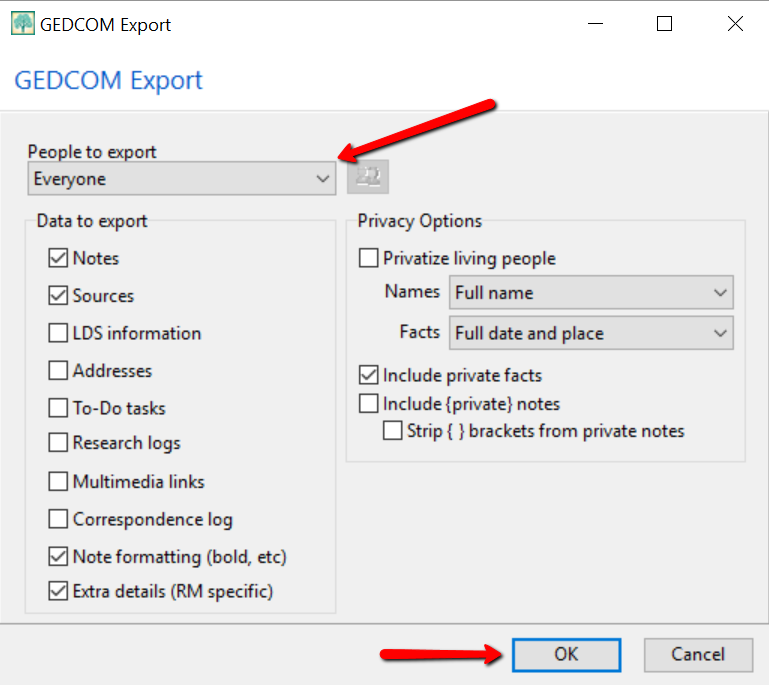
Once you have clicked OK, the GEDCOM file is ready to be saved to your computer. Save the file on your desktop or somewhere you will be able to locate it again. Remember to name the file and pay attention to where you are saving it!
Creating a GEDCOM from Ancestry.com
If you have stored your genealogy data at Ancestry.com, you may be interested to know that you can create a GEDCOM file for your family tree there as well. It’s just a matter of signing into your Ancestry account, locating the Tree Settings, and then clicking Export. I found a nice article outlining the steps on how to do that here.
Protecting Your GEDCOM Files
Creating a GEDCOM is also a great way to save or backup your hours and hours of family history research. One of the saddest tales of genealogists everywhere is losing their computer or printed family files with all that work!
GEDCOM files can be saved to a hard drive, saved to an external unit, emailed, put on a thumb drive, or uploaded to the Cloud. You can also invest in a company like Backblaze, the official backup of The Genealogy Gems Podcast, that will automatically backup all your files. (Read more about Backblaze, here.) All of these methods protect you and your genealogy.
More on Protecting Your Genealogical Data
Learn more about Backblaze, The Genealogy Gems Podcast’s first choice when it comes to backing up precious genealogy research and personal files. Read the article’s below and determine if Backblaze is the answer you’ve been looking for.
How to Download Backblaze in 4 Easy Steps
Backing Up Your Genealogy with Backblaze – Q & A
by Lisa Cooke | Mar 10, 2017 | 01 What's New, Irish, Records & databases
We are bringing you Irish historical photographs from Dublin this month in celebration of Irish heritage. Search these amazing photos of your ancestral homeland. Also this week, directories from Scotland, church records of the United Kingdom, and censuses for Canada and New York State.
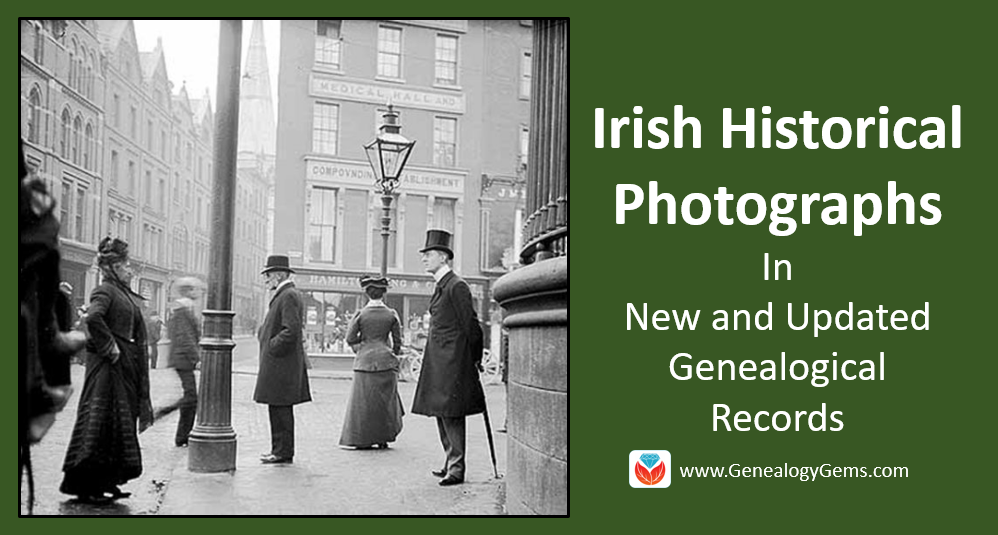
Ireland – Dublin – Irish Historical Photographs
The Dublin [Ireland] City Council has launched an online archive of over 43,000 Irish historical photographs and documents to their website. These amazing photographs can be searched by archive, date, or location for free. They show images of events like the
Eucharistic Congress and the
North Strand Bombing. There are also images of football games, bus strikes, and old Dublin streets.
These Irish historical photographs includes pictures of old documents and objects, too, with the oldest document dated to 1757!
Take a look at the entire archive, here.
More on Beginning Irish Genealogy
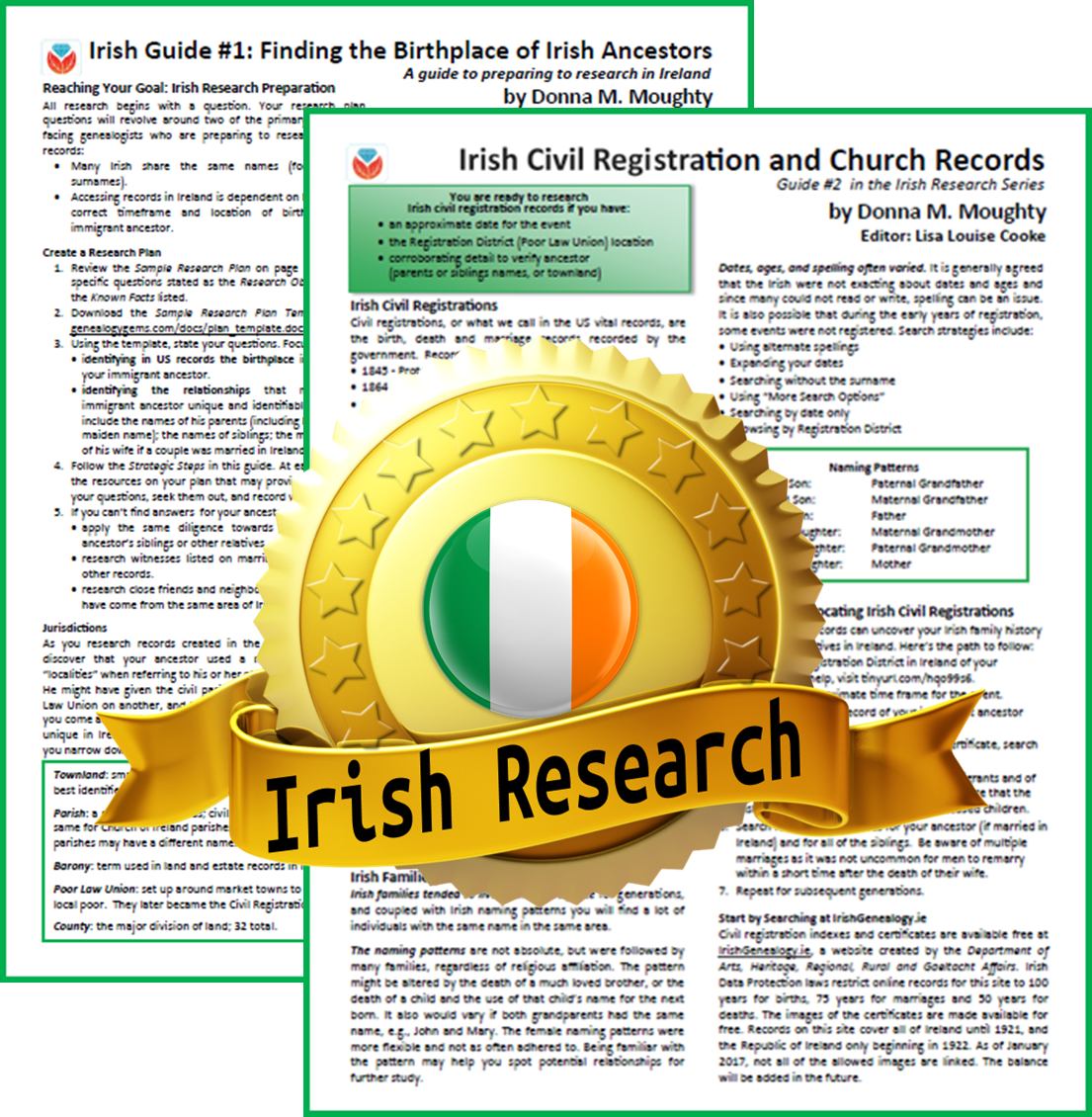 You’ll love these two quick-guides by Donna Moughty on Irish genealogy. Guide #1 titled Preparing for Success in Irish Records Research will help you determine a birth place, differentiate between persons with the same name, and walk you through identifying helpful US records.
You’ll love these two quick-guides by Donna Moughty on Irish genealogy. Guide #1 titled Preparing for Success in Irish Records Research will help you determine a birth place, differentiate between persons with the same name, and walk you through identifying helpful US records.
Guide #2 titled Irish Civil Registration and Church Records, will guide you through locating Protestant church records, civil registrations, and more. It will also walk you step-by-step through using the new online Civil Registration records.
And now, purchase these quick-guides as a bundle
Scotland – Post Office Directories
Scotland Post Office Directories contains over 382,000 records and allows you to explore thousands of pages of directories to learn more about the life and work of your Scottish ancestors. This Findmypast collection focuses on a particular town or district although a number of national postal directories are also included. The majority comprise a description of the place along with lists of people by occupation. For example, you will find lists of magistrates, councilors, sheriffs, police officers, and merchants.
The records are do not contain transcripts, but do include a digital image. The detail you will find on each page will depend on the type and date of the directory.
In conjunction with these post office directories, there are some that are browse-image only. They have not been indexed at this time. These 598 volumes of the Scotland Post Office Directories Image Browse are an excellent source for family history and those who need to trace their ancestors on a yearly basis.
Canada – 1842 Census
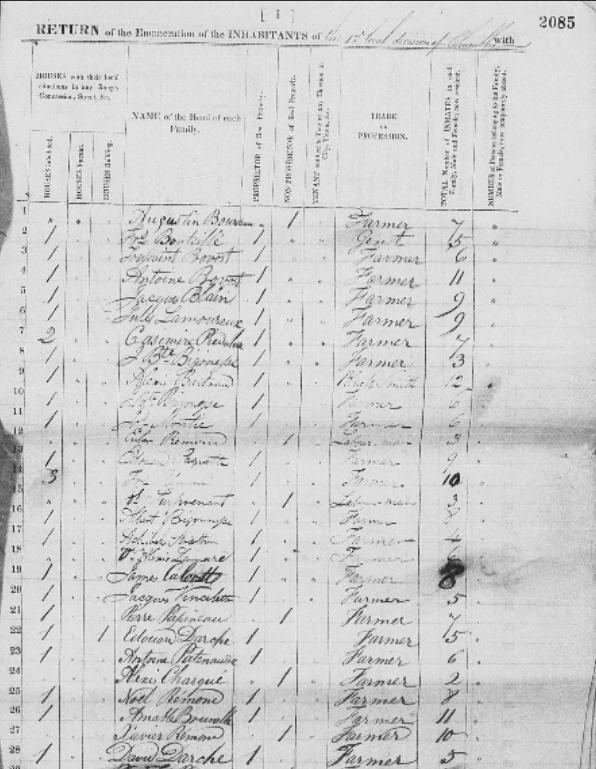
The Lower Canada Census 1842 at Findmypast contains over 46,000 records. The Province of Lower Canada was a British colony on the lower Saint Lawrence River and the shores of the Gulf of Saint Lawrence between 1791 and 1841. It covered the southern portion of the modern-day Province of Quebec and the Labrador region of the Province of Newfoundland and Labrador.
Each search result will include an image of the original document and a transcript. The original returns were printed in French and English and transcripts may include occupation, language, residence, and the number of inhabitants at their dwelling. Images can provide detailed information about the local area such as number of inhabited and uninhabited buildings, the number of barley mills, tanneries, distilleries, the price of wheat since last harvest, and the price of agricultural labor per day.
United Kingdom – London – Russian Orthodox Church Records
Findmypast has added records to their collection titled Britain, Russian Orthodox Church in London. Over 13,000 records taken from volumes of birth, marriage, and death records from the Russian Orthodox Church in London in exist is this collection. The records further include correspondences, congregational records, and church documents. The majority of the volumes are written in Russian although a limited number of English-language records are available.
The Russian Orthodox Church records are available as a browse set only at this time. You will need to search the records by the document description such as Births, marriages, deaths, converts, and passports, 1888-1919 or Donations to St Petersburg Guardianship for Poor Clergymen, 1863. Then, search within the digitized volume to find your ancestor.
You will find numerous correspondences with other church leaders in London, America, Russia, and Japan, as well as documents related to religious doctrine. The facts found in each volume will depend on the type of record you are viewing. Birth, marriage, and death records will typically include the individual’s name, event date, and place, while birth and marriage records may also include the names of the individual’s parents.
United Kingdom – War Records
New records have been added to the Findmypast collection of Anglo-Boer War Records 1899-1902. This unique database of more than 470 sources may reveal the unit your ancestor served with and any medals, honors, or awards they won. The register also contains a completely revised casualty list of 59,000 casualty records.
Each record contains a transcript and may include the following information:
- Name
- Service number and rank,
- Unit & regiment
- Medals, honors or awards received
- Memorials relating to death if applicable
United Kingdom – England – Births and Christenings
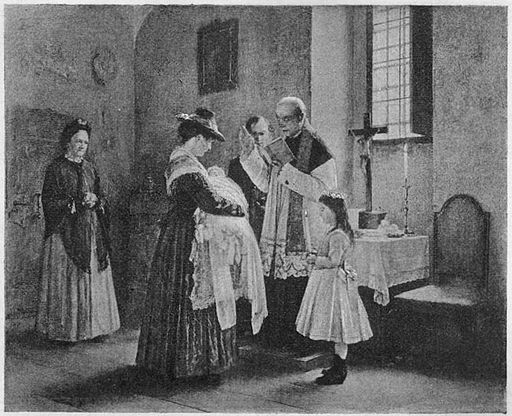
By Anton Laupheimer [Public domain], via Wikimedia Commons
Though this collection from FamilySearch has been available for awhile, they have recently added more records. The
England Births and Christenings, 1538-1975 now totals over 68 million records. There are some important tips and known problems with this database. Before searching, be sure to read the details at the FamilySearch Wiki,
here. As an example: In birth or christening records, if a surname is not listed for the child, the indexer often assigns the father’s surname to the child. This surname may not be correct. So if you are looking for a birth or christening, search by the given name of the child, adding parents’ names and as much locality information as is permitted.
United States – New York – State Census
FamilySearch has added to the New York State Census of 1865 this week. State censuses are particularly helpful to researchers because they fill in the gap between federal censuses. Unfortunately, the following counties are missing:
- Allegany
- Clinton
- Franklin
- Genesee
- Hamilton
- New York
- Putnam
- Queens
- Seneca
- St Lawrence
- Sullivan
- Westchester
- Wyoming
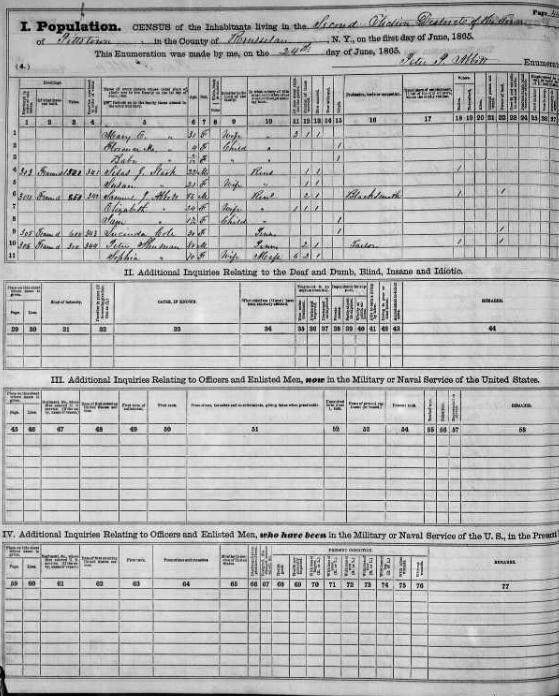 The population schedule includes the name, age, birthplace, and occupation of each household member as most censuses do.
The population schedule includes the name, age, birthplace, and occupation of each household member as most censuses do.
However, this census also includes two military schedules with information of officers and enlisted men currently in the military and men who had served in the military. This census contains information on when and where the individual first entered the military, rank, how long they were in the service, their present health, as well as several other items.
Additionally, the census contains tables on marriages and deaths occurring during the year ending June 1, 1865. These tables contain typical marriage and death information, but can be a helpful resource for those who have been unable to find these records in traditional locations.
Lastly, a second table entitled deaths of officers and enlisted men contains deaths of individuals which had occurred while in the military or naval service of the United States, or from wounds or disease acquired in said service since April, 1861, reported by the families to which the deceased belonged when at home. It includes the name of the deceased, age at death, if married or single, if a citizen, several items relating to military information, date of death, place of death, manner of death, survivors of the deceased, place of burial and any remarks.
 If you haven’t had the chance to listen to Genealogy Gems Podcast episode 196, I’d like to share a few highlights regarding getting started with Irish genealogy. We all know it can be difficult, and there are lots of rumors suggesting records no longer exist. Here are a few key points Kate Eakman shared with me in our interview.
If you haven’t had the chance to listen to Genealogy Gems Podcast episode 196, I’d like to share a few highlights regarding getting started with Irish genealogy. We all know it can be difficult, and there are lots of rumors suggesting records no longer exist. Here are a few key points Kate Eakman shared with me in our interview.
 A: Our process is easy. If you just need help figuring our your next steps, a Genealogist-on-Demand™ 45-minute genealogy consultation for just $100 is the ideal solution. Learn more and schedule your appointment here.
A: Our process is easy. If you just need help figuring our your next steps, a Genealogist-on-Demand™ 45-minute genealogy consultation for just $100 is the ideal solution. Learn more and schedule your appointment here. Are you listening to The Genealogy Gems Podcast yet? This free audio show helps you make the most of your family history research time by providing quick and easy-to-use research techniques. Producer and host Lisa Louise Cooke brings you the best websites, best practices, and best resources available. This podcast is 100% free! Click here to start listening right now on our computer.
Are you listening to The Genealogy Gems Podcast yet? This free audio show helps you make the most of your family history research time by providing quick and easy-to-use research techniques. Producer and host Lisa Louise Cooke brings you the best websites, best practices, and best resources available. This podcast is 100% free! Click here to start listening right now on our computer.


 So what does this mean for you as a genealogist?
So what does this mean for you as a genealogist?













 The population schedule includes the name, age, birthplace, and occupation of each household member as most censuses do.
The population schedule includes the name, age, birthplace, and occupation of each household member as most censuses do.


